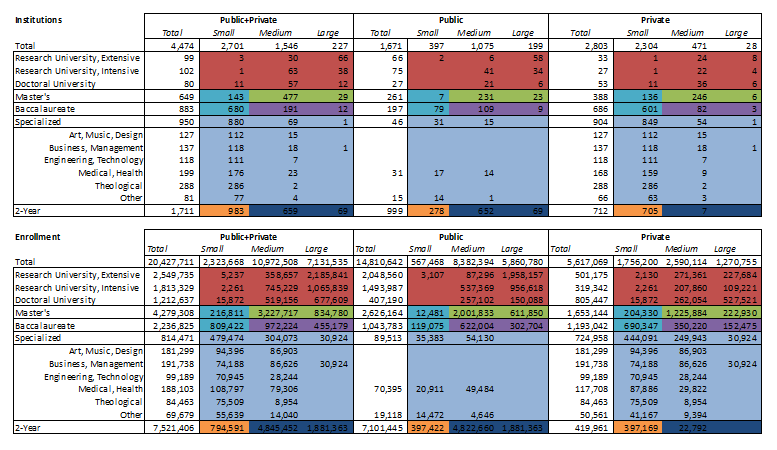Institutional Demography in Higher Education: A Reminder
To understand why policy debates sometimes seem to make no sense, to circle endlessly, or to become bafflingly confused, it’s important to remember that the demography of higher education isn’t politically straightforward. By “demography” I don’t mean Gen X, Gen Y, and echo booms, but rather straightforward counts of degree-granting institutions and students. And by “politically” I don’t mean Republicans and Democrats, but rather the relative importance of different constituencies with different resources and goals.
Here’s a graph (I’ll append a more detailed table at the end). The data come from the National Center for Educational Statistics 2008 IPEDS surveys. They describe the 4,474 public and private degree-granting institutions in the United States, classified into the usual Carnegie categories. I’ve collapsed Carnegie and size categories: “Small” means enrollment under 2,500, and “Large” means enrollment of 20,000 or more. The categories whose labels I’ve italicized are mostly private, those I’ve underscored are mostly public, and those I’ve both italicized and underscored are split between public and private institutions.
Most of us know some key demographic facts about higher education — for example, that the largest group of students is in 2-year colleges, followed closely by research universities. We also know that an awful lot of commentary and influence in higher education comes from people in or connected with research universities, and therefore many of us have trouble thinking about other kinds of institutions, let alone new kinds.
Here are some things we tend to forget:
- There really aren’t very many research and doctoral universities — they account for fewer than 10% of institutions even though they enroll over 25% of all students.
- Although there are lots of big community colleges and they enroll lots of students, not all 2-year colleges are big community colleges; rather, more than half of them are small, and most of those are private.
- Most small 4-year and master’s institutions are also private, and although they comprise almost 20% of all institutions, they enroll only 5% of all students.
- There are a lot of specialized institutions — that is, freestanding business, health, medical, engineering, technical, design, theological, and other similar institutions — but they don’t enroll very many students.
- Enrollment isn’t quite a Pareto distribution (that’s the classic 20-80 rule), but it’s pretty close: 33% of institutions enroll 80% of the students.
What this tells us is that the politics of higher education — and, indeed, the politics of organizations, like my own EDUCAUSE, that try to represent all of higher education — are very different depending on whether we focus on students or on institutions.
If we focus on students, the politics are pretty straightforward. Big community colleges, big master’s institutions, and doctoral and research universities count, and all other institutions don’t. The group that counts is mostly public institutions, so state governments and state system offices also count. Research and doctoral universities employ lots of faculty to whom research is as important as teaching, and who are vocal about its importance, so disciplinary groups and research funders are also relevant.
From the enrollment perspective, how higher education evolves depends critically on what happens in big community colleges and in research and doctoral universities, since that’s where students are. Conversely, unless those institutions adapt to what students expect, we can expect cataclysmic change in higher education.
But community colleges and universities are at opposite ends of the cultural spectrum. To give just two examples, the former rely heavily on faculty hired ad hoc to teach specific courses, the latter rely on tenured or tenure-track faculty, and the former have no interest in research productivity or eminence whereas the latter stake their reputations on it. So the two most important sectors (in the enrollment sense) often are misaligned if not at odds about policy choices, and the changes they contemplate and implement are likely to be divergent rather than synergistic.
The other 3,000 institutions are different. Of the 4,474 institutions, almost 2/3 are private, and almost 2/3 are small, with lots of overlap: just over half of all institutions are small and private. If we focus on institutions rather than enrollment, we attend to a very large number of small, private institutions that often have different missions and challenges, typically do not work together, and, with a few exceptions, are not organized or collectively vocal.
For these institutions, the difference between survival and demise can depend on tiny changes in enrollment or financial aid or even audit policies, since their small size denies them the operating cushions and economies of scale available to their larger and public counterparts. This also means that these institutions have no excess resources to invest in innovation, so they are unlikely to adapt to changing student needs.
In a sense, focusing on enrollment tends to yield interesting and strategic (if conflicting) attention to the future, whereas focusing on institutions tends to balance (if not replace) this with a focus on tactical survival and the intricacies of current policy.
But my point isn’t about specific policy options or imperatives. Rather, it’s this: what’s important varies dramatically depending whether we focus on institutions or students. And that, I think, not only contributes to the complexity of our conversations within the status quo of higher education, but also complicates thinking about its future.


